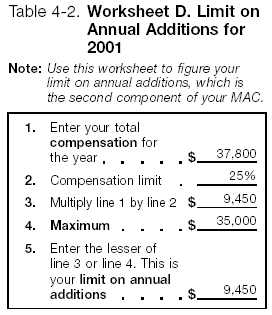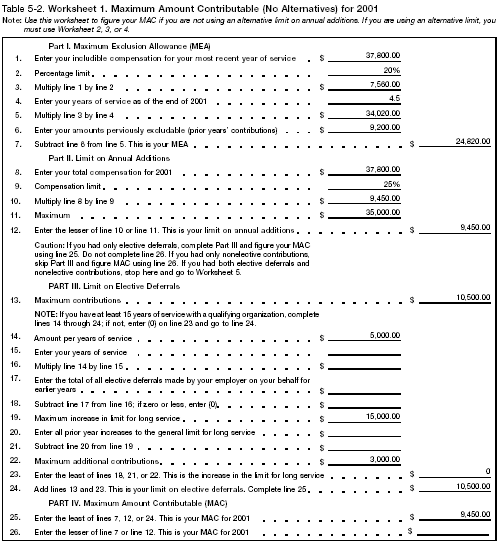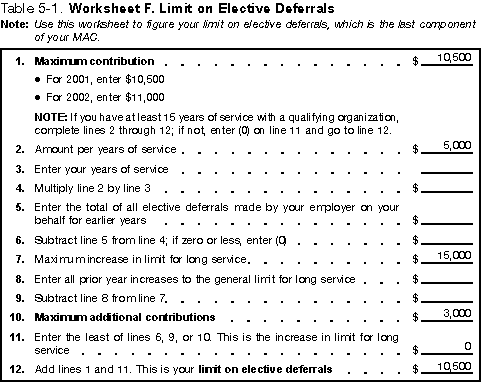 |
2002 Tax Help Archives |
Jerry's employer has set up a 403(b) account for him. In this account, Jerry has chosen to invest 8% of his salary each year in mutual funds through payroll reductions. For 2001, this is $2,800. Jerry is not using an alternative limit on annual additions. Figure Jerry's years of service. The first thing Jerry will need to do is figure his years of service. In 1997, Jerry worked ½ of the year for his employer. For the years 1998 through 2001, Jerry has been a full-time employee for each of the hospital's entire annual work periods. Jerry's years of service at the end of 2001 total 4.5 years. Figure Jerry's includible compensation. The second thing for Jerry to figure is his includible compensation for his most recent year of service. Before he can do this, he must identify his most recent year of service. Jerry is a full-time employee who works the entire annual work period. Jerry's most recent year of service is 2001. Jerry figures his includible compensation as shown in Table 3-6. Figure Jerry's amounts previously excludable. Jerry's next step is to figure his amounts previously excludable. The 8% contributions made through a salary reduction agreement equal $9,200. Jerry's MEA. Using the figures for years of service, includible compensation, and amounts previously excludable, Jerry can now use Worksheet A to figure his MEA as shown in Table 3-7. Figuring Jerry's MAC Jerry's MEA for 2001 is $24,820. However, this is not the maximum amount that can be contributed to his 403(b) account. To determine his MAC, Jerry will need to figure his limit on annual additions (chapter 4) and his limit on elective deferrals (chapter 5).
Table 3.6 and Table 3.7 Table for Includible compensation and Maximum exclusion allowance
Limit on Annual Additions for 2001
This chapter applies only to contributions made in 2001. For the rules on figuring the limit on annual additions for 2002, see chapter 9.
The second component of MAC for 2001 is the limit on annual additions. This is a limit on the total contributions (elective deferrals, nonelective
deferrals, and after-tax contributions) that could have been made to your account for 2001. You can figure the limit on annual additions using either
of the following.
This chapter will discuss figuring the limit on annual additions using the general rule. For information on the alternative limits, see chapter 6.
Under the general rule, the limit on annual additions is the lesser of:
Generally, your limitation year is the calendar year. However, you can elect to change your limitation year to any consecutive 12-month period. To
do this, attach a statement to your individual income tax return for the year you make the change.
You can use Worksheet D in chapter 13 to figure your limit on annual additions under the general rule.
Participation in a qualified plan. If you participated in a 403(b) plan and a qualified plan, you must combine contributions made to
your 403(b) account with contributions to a qualified plan and simplified employee pensions of all corporations, partnerships, and sole
proprietorships in which you have more than 50% control.
Table 4–1 Jerry's Compensation worksheet
Figuring the Limit on Annual Additions To figure the limit on annual additions under the general rule, you will need to determine what is and is not compensation. Generally, compensation
includes:
Generally, compensation does not include:
Note.
Compensation for purposes of the limit on annual additions for 2001 is not the same as includible compensation discussed in chapter 3.
Example Using the same facts presented in the last Example in chapter 3, Jerry is now ready to figure the second component of his MAC, the limit
on annual additions.
Figure Jerry's compensation.
The first step in determining the limit on annual additions is to figure compensation. Jerry's compensation is shown in Table 4-1.
Figure Jerry's limit on annual additions.
After determining compensation, Jerry is now ready to figure the limit on annual additions.
Jerry's limit on annual additions is $9,450 as shown in Table 4-2.
Figuring Jerry's MAC Jerry has figured both his MEA and his limit on annual additions. To figure his MAC for 2001, Jerry must figure his limit on elective deferrals.
This limit is explained in chapter 5.
Table 4-2. Worksheet D. Limit on Annual Additions for 2001
Limit on Elective Deferrals Important Changes for 2002 Increase in the limit on elective deferrals.
Effective for years beginning in 2002, the limit on elective deferrals has been increased from $10,500 to $11,000.
Credit for elective deferrals.
Effective for years beginning after 2001, you may be eligible to take a percentage of your actual elective deferrals as a credit. For more
information, see Publication 553.
You can use this chapter to determine your limit on elective deferrals for 2001 and 2002.
The final component of MAC is the limit on elective deferrals. This is a limit on the amount of contributions that can be made to your account
through a salary reduction agreement.
A salary reduction agreement is an agreement between you and your employer allowing for a portion of your compensation to be directly
invested in a 403(b) account on your behalf. You can enter into more than one salary reduction agreement during a year.
This chapter discusses:
403(b) plan and another retirement plan. If, during the year, contributions in the form of elective deferrals are made to other
retirement plans on your behalf, you must combine all of the elective deferrals to determine if they are more than your limit on elective deferrals.
The limit on elective deferrals applies to amounts contributed to:
General Limit Under the general limit on elective deferrals, the most that can be contributed to your 403(b) account through a salary reduction agreement for
2001 is $10,500. The limit for 2002 is $11,000. This limit applies without regard to community property laws.
Excess elective deferrals.
If the amount contributed is more than the allowable limit, you must include the excess in your gross income for the year contributed. This is
explained in chapter 11.
15-Year Rule If you have at least 15 years of service with a public school system, hospital, home health service agency, health and welfare service agency,
church, or convention or association of churches (or associated organization), and you are an eligible employee (as described in chapter 1), the limit
on elective deferrals to your 403(b) account is increased by the least of:
If you qualify for the 15-year rule, your elective deferrals under this limit can be as high as $13,500 for 2001 and $14,000 for 2002.
Excess elective deferrals.
If the amount contributed is more than the allowable limit, you must include the excess in your gross income for the year contributed. This is
explained in chapter 11.
Figuring the Limit on Elective Deferrals Worksheet F in chapter 13 can be used to figure the limit on elective deferrals.
Example Based on the rules in chapters 3 and 4, Jerry has figured his MEA and his limit on annual additions. The last component needed before he can
determine his MAC for 2001 is the limit on elective deferrals.
Figuring Jerry's limit on elective deferrals.
Jerry has been employed with his current employer for less than 15 years. He is not eligible for the special 15-year increase. Therefore, his limit
on elective deferrals is $10,500, as shown in Table 5-1.
Figuring Jerry's MAC Jerry has determined his MEA to be $24,820. His limit on annual additions is $9,450 and his limit on elective deferrals is $10,500. Based on this,
the maximum amount that could have been contributed to a 403(b) account on Jerry's behalf in 2001 is $9,450, the least of the three limits.
All three components are pulled together in Table 5-2.
Table 5-2. Worksheet 1. Maximum Amount Contributable for 2001
Table 5-1. Worksheet F. Limit on Elective Deferrals
Table 5-1.Worksheet F. Limit on Elective Deferrals
Alternative Limits on Annual Additions
This chapter applies only to contributions made in 2001. For years beginning after 2001, the alternative limits on annual additions have been
repealed. For information on figuring your limit on annual additions for 2002, see chapter 9.
Certain employees can choose to increase their MAC by electing an alternative limit on annual additions. There are three alternative limits.
This chapter will discuss the following topics.
The general limit on annual additions is discussed in chapter 4.
Effect of election.
Generally, the election to use either the any year limit or the year of separation from service limit allows you to exclude from gross income a
larger amount of employer contributions than would have been allowed under the general rule that limits employer contributions to 25% of your
compensation. If you elect to use the overall limit, you may be able to exclude a larger amount because you can disregard the MEA that would otherwise
apply.
Excess contributions.
If employer contributions were included in your income for a tax year because they exceeded any of these alternative limits for that year, the
excess reduces the amount of your MEA for later years, even though the excess has already been included in your income.
Publication Index | 2002 Tax Help Archives | Tax Help Archives | Home © 2004, UncleFed.com
|
|||||||||||||||||||
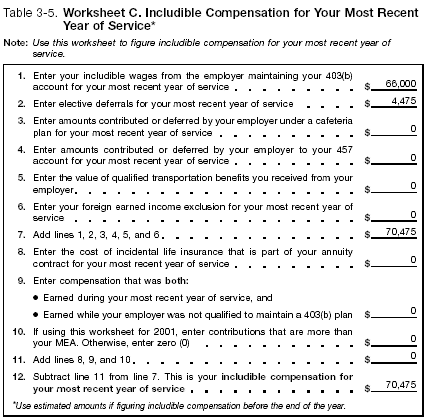
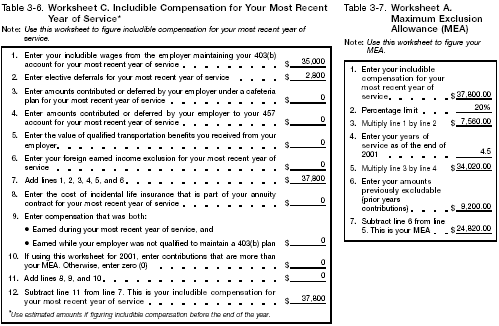
 More than one 403(b) account. If you contributed to more than one 403(b) account you must combine the contributions made to all 403(b)
accounts on your behalf by your employer.
More than one 403(b) account. If you contributed to more than one 403(b) account you must combine the contributions made to all 403(b)
accounts on your behalf by your employer.
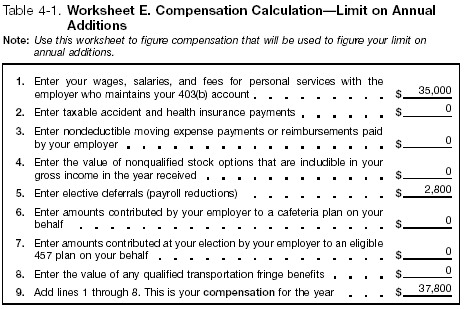
 Worksheet E. Compensation Calculation - Limit on Annual Additions, in chapter 13, can help you figure your compensation for the
limit on annual additions.
Worksheet E. Compensation Calculation - Limit on Annual Additions, in chapter 13, can help you figure your compensation for the
limit on annual additions.
